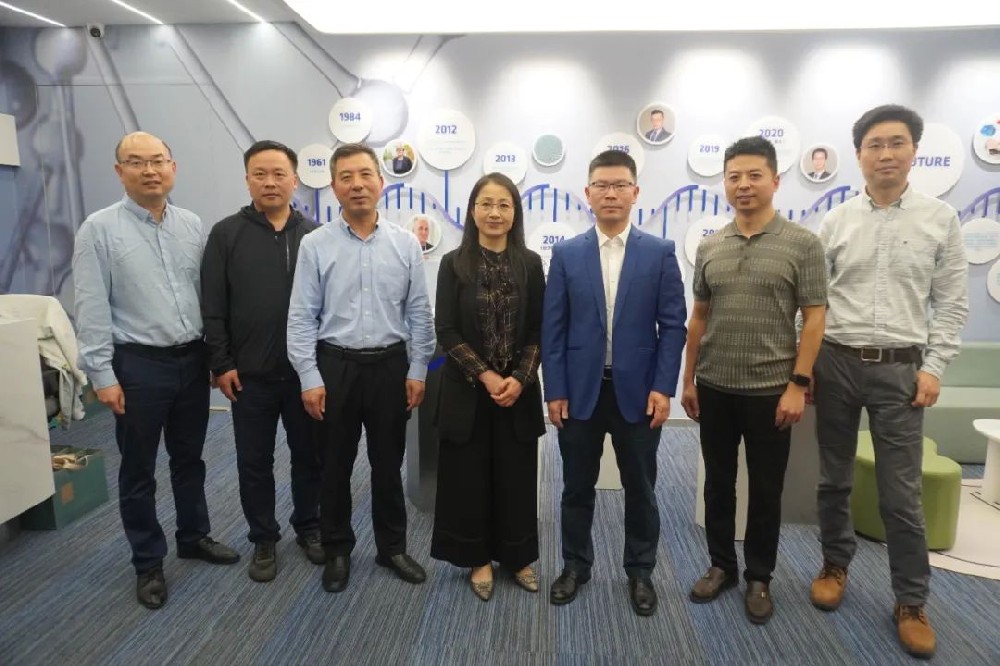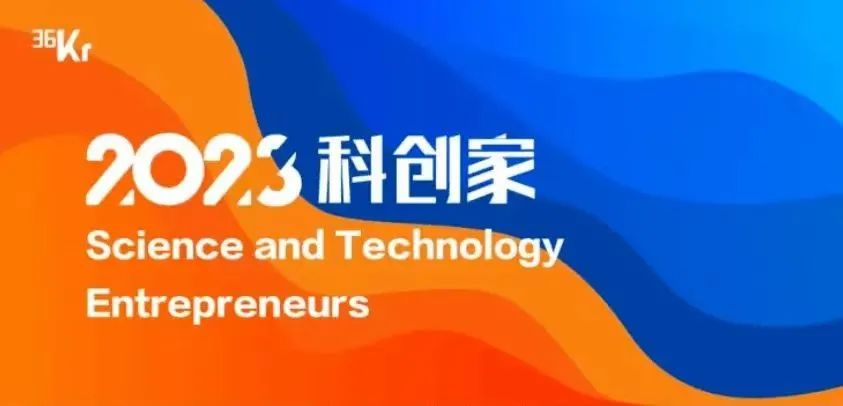当前位置:首页 / News / Company News
New progress in sequencing: sewage can also be used to monitor and trace the source of the new coronavirus
时间:2021-10-11 16:15:22 文章来源:苏州澳门威尼克斯人网站
Introduction
Recently, AWMC (The University of Queensland) and BGI published the title "Novel Multiplexed Amplicon-Based Sequencing to Quantify SARS-CoV-2 RNA from Wastewater" in Environmental Science & Technology Letters. Research papers. The article introduces a multiplexed amplicon-based sequencing method (Multiplexed Amplicon-based Sequencing) to realize the accurate detection of SARS-CoV-2 RNA in municipal sewage. It is worth mentioning that the research was completed with MGI's comprehensive, flexible and efficient MGISEQ-2000 gene sequencer and ATOPlex multiplex PCR customized platform.
Compared with conventional RT-qPCR, this method can not only detect the new coronavirus with high sensitivity, but also accurately obtain viral load information and viral genome information. This information can be used to judge the prevalence of the urban epidemic and the pandemic Traceability of the new coronavirus variants. In addition, the research results show that the solid-phase suspended solids or particulates in urban sewage also contain a large amount of SARS-CoV-2 RNA. The research is expected to further promote the application of sewage epidemiology in public health emergency response.
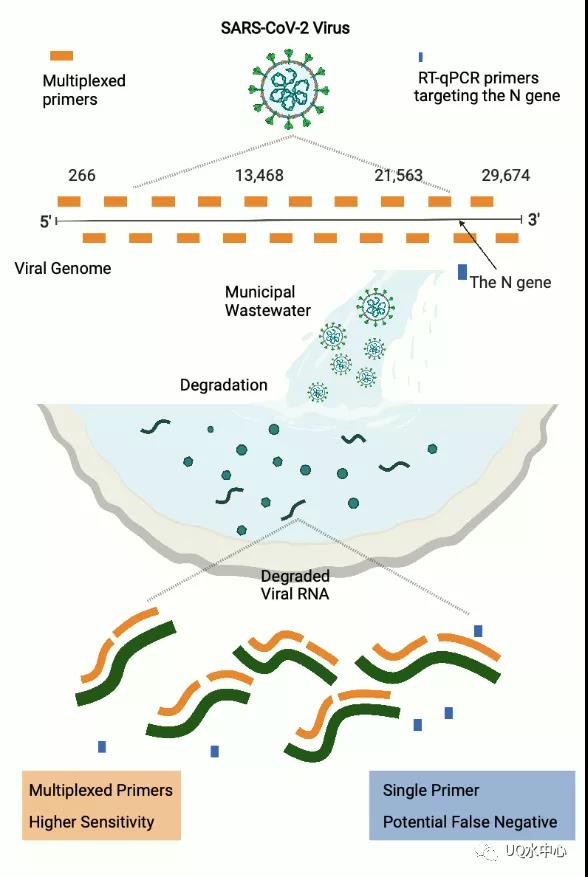
引言
The current global pandemic of new coronary pneumonia caused by SARS-CoV-2 is a public health emergency of widespread concern in the international community. As of July 12, more than 180 million people have been infected worldwide and more than 4 million deaths have been caused. Non-pharmacological interventions, including social distancing, wearing masks, timely isolation of infected persons and close contacts, and restrictions on the scope of human activities, have been adopted by governments to slow the spread of the new coronavirus in the community.
However, because many virus carriers are asymptomatic patients, there are certain limitations and lags in measuring the prevalence of the virus in the community through clinical tests. The latest research progress shows that Wastewater-Based Epidemiology (WBE) can detect the presence of the virus at a time point earlier than the detection of the medical system, and is not interfered by asymptomatic infections. This is the new crown epidemic From another level, the management and control provides new early warning information, and can help relevant departments to make public health decisions more effectively.
With the COVID-19 pandemic, WBE has received increasing attention from government health agencies and research teams. However, due to the low concentration of SARS-CoV-2 in sewage, how to detect SARS-CoV-2 in urban sewage accurately, sensitively and with high throughput still faces challenges.
What are the current detection methods?
At present, most of the conventional detection schemes are based on polymerase chain reaction (PCR), such as reverse transcription real-time fluorescent PCR (RT-qPCR) and reverse transcription droplet digital PCR (RT-ddPCR). Although RT-qPCR and RT-ddPCR are very sensitive, because the urban sewage pipe network is a large and complex system, RNA will be highly diluted and degraded in sewage. On the other hand, RNA viruses are extremely unstable, and it is quite difficult to obtain high-quality genomes from the environment. The N1/N2/N3 amplification primers generally used by RT-qPCR and RT-ddPCR are less than 1% of the coverage area of the viral genome (~30000bp). This means that if the RNA sequence at the primer target site is degraded, it will cause false negative results (off-target).
You may be wondering whether the Metatranscriptomics detection method is feasible? Compared with PCR-based methods, the advantage of the macrotranscriptome technology is that it can capture all RNA virus fragments in the environment, from which the gene sequence of SARS-CoV-2 can be obtained. However, since virus particles will be highly diluted and degraded after leaving the human body and entering the urban sewage pipe network, the degraded virus fragments will be mixed with other sewage microbiome (sewagemicrobiome). Therefore, in order to use the macrotranscriptome to quantify SARS-CoV-2 in sewage, it is necessary to complete ultra-deepsequencing of urban sewage samples, which means a large amount of capital investment and requires follow-up with highly specialized biological information analysis. Process.
It can be seen that a low-cost and high-efficiency sequencing method is very necessary. Multiplex PCR sequencing technology (MultiplexedAmplicon-based Sequencing) is a new type of sequencing technology developed on the basis of conventional PCR, which can detect multiple targets at the same time, which not only saves time and cost, but also extracts from a limited genome A lot of information. ATOPlex is a multiplex PCR technology platform developed by MGI (MGI). By using multiple mixed primers to capture the whole genome sequence information of the new coronavirus, it can realize the enrichment of low-concentration viruses and high-throughput sequencing. This new sequencing method has a simple operation process (see Figure 1), has extremely high sensitivity, can accurately quantify viruses, and can obtain complete genome information, thereby realizing virus detection, quantification, and traceability analysis.
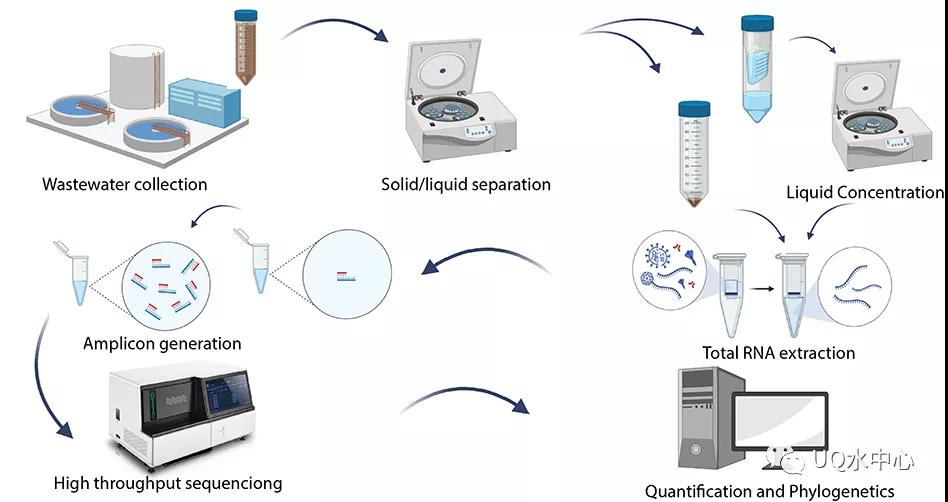
1. New Coronavirus Detection Flow in Urban Sewage
Results and discussion
ATOPlex enables more sensitive virus quantification
At the same time, RT-ddPCR absolute quantification and ATOPlex sequencing were performed on the positive samples of the gradient dilution. The ratio of the number of new crown reads obtained by ATOPlex (SARS-CoV-2/Spike-incontrol) was highly positively correlated with the virus concentration (R2 = 0.993), and the virus sequence The ratio can be a good representative of the virus content.
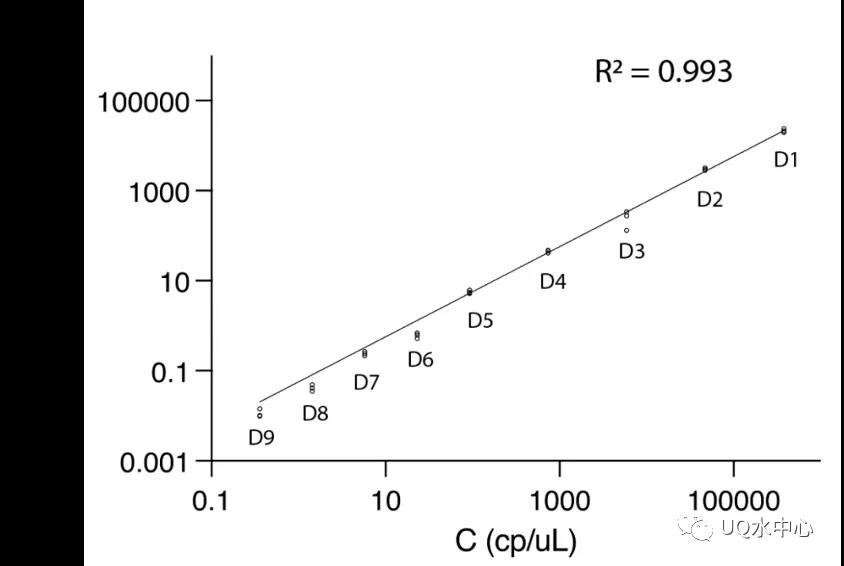
Figure 2. Correlation analysis between ATOPlex and RT-ddPCR
In addition, through comparison, it is found that ATOPlex technology is more sensitive than conventional RT-qPCR. When the virus content is near the detection limit of RT-qPCR, RT-qPCR may give false negatives, but ATOPlex can obtain virus-based information stably, and 96.9% of the genome information can be obtained, even when the virus concentration is lower than the detection limit by an order of magnitude At this time, ATOPlex can still recover 8.4% of the viral genome (see Table 1). Therefore, ATOPlex technology can more sensitively detect low-concentration viruses in sewage.
Table 1. Comparison of standard deviation of N1 and N2 primer detection between ATOPlex and qPCR (positive control dilution series)
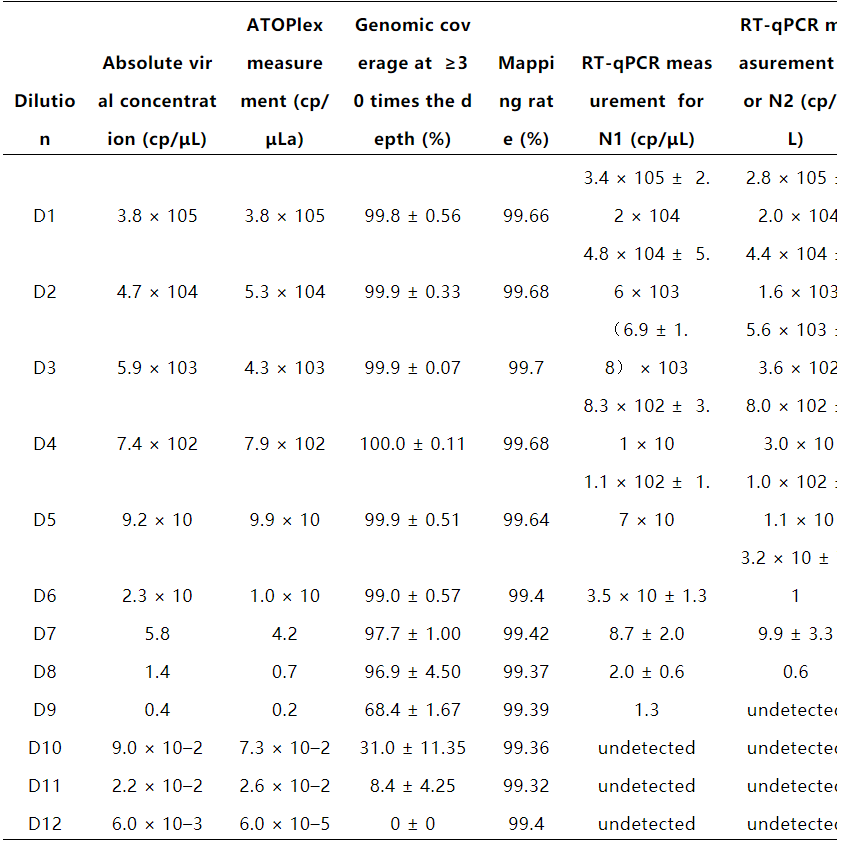
ATOPlex can realize virus traceability analysis
RT-qPCR can only give quantitative information, but ATOPlex sequencing technology can restore the genome information of the virus as much as possible, so as to accurately and quickly trace the virus variants. Systematic chemical research and analysis of the genome of the positive sample found that the traceability results are still accurate when the virus concentration is lower than a quarter of the RT-qPCR detection limit (Figure 3).
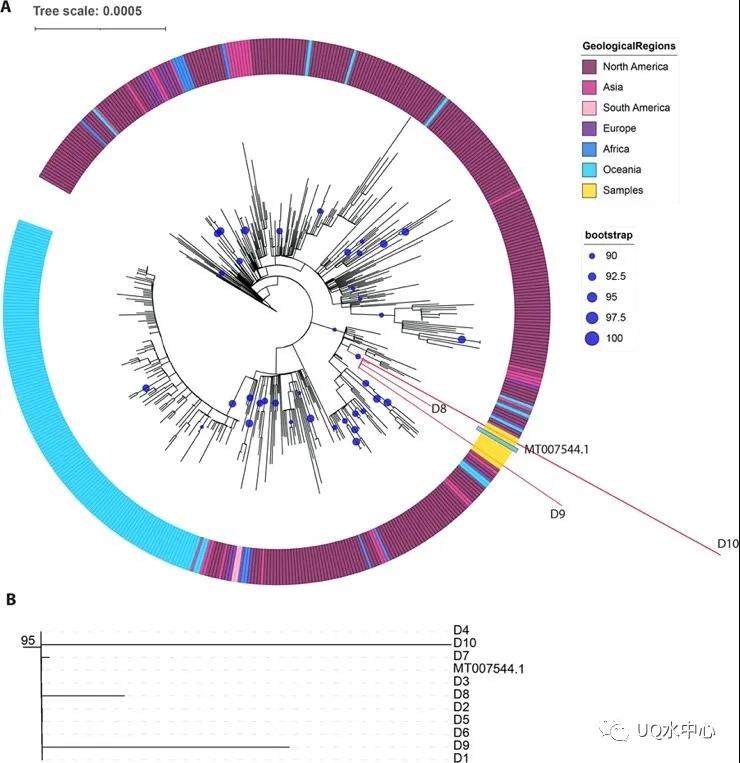
Figure 3. Phylogenetic analysis of positive samples
There may be a large number of viruses in the particles in municipal sewage
In the past, most WEBs used the liquid phase part of the sewage to extract and detect, ignoring the virus particles adsorbed in the solid phase suspension in the sewage. The analysis of RNA extracts using RT-qPCR and ATOPlex technology showed that the virus signal intensity in the solid phase was even higher than that in the liquid phase (Figure 4). The particles or solid matter in urban sewage may contain a large number of viruses, which cannot be ignored in WEB analysis.
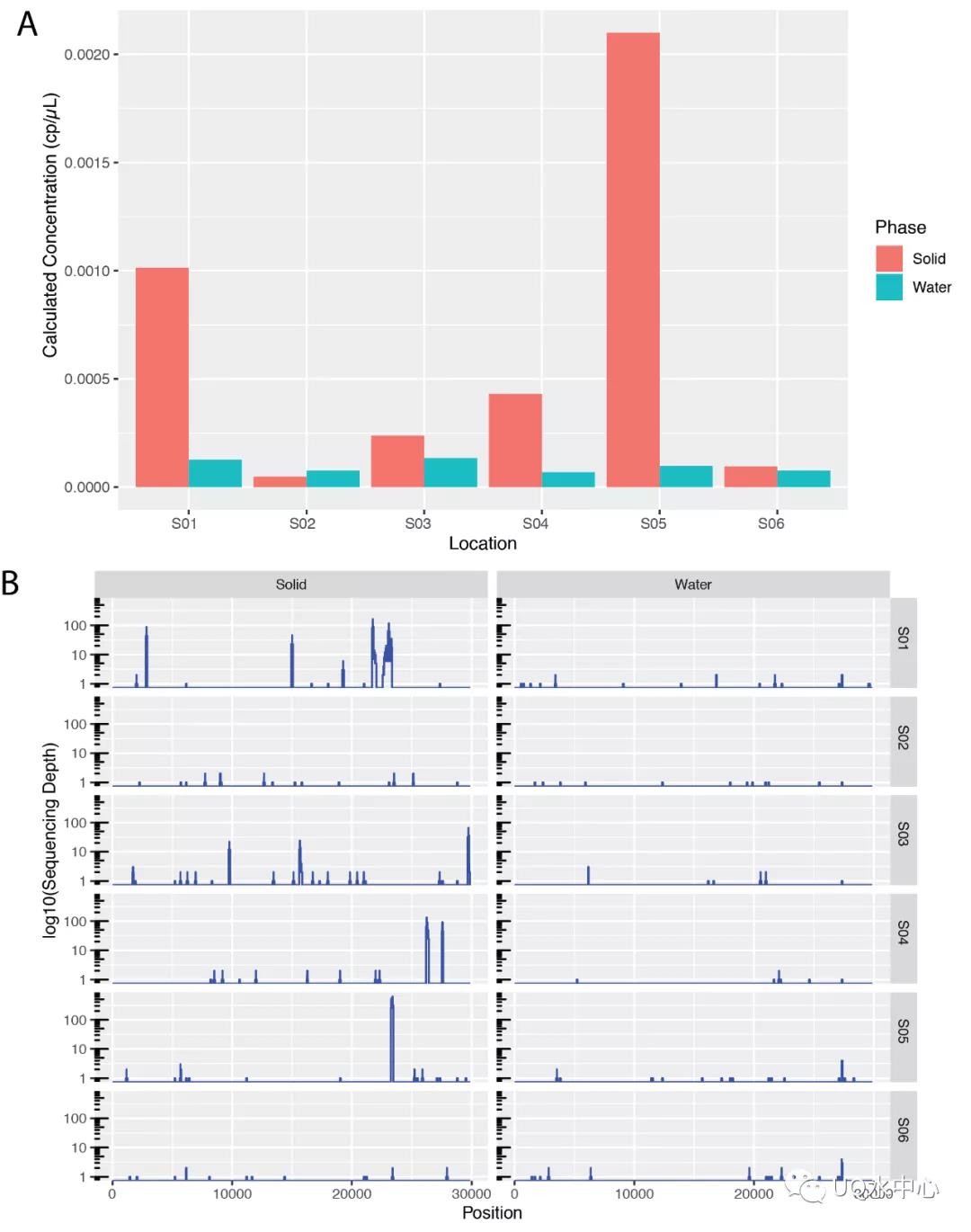
Figure 4. The virus content in sewage is higher in solid phase than in liquid phase. A: Contrast of virus concentration in liquid phase and solid phase of six real sewage samples. B: Sample genome coverage
Summarize
The research successfully applied a new method based on multiple amplicon sequencing (ie, the ATOPlex technology platform) to detect SARS-CoV-2 in municipal sewage. This method can realize highly sensitive and high-throughput quantitative analysis of SARS-CoV-2 in sewage, and can trace the information of virus phylogeny, which is conducive to the further application and development of WBE in public health emergency.
At the same time, the primers, PCR conditions, and biological information analysis methods used in each sample of this technology are open to the public (OpenSource) to promote the application and promotion of the technology. We also look forward to further exchanges and cooperation with interested counterparts and institutions to develop other pathogenic microorganism detection and traceability solutions based on the ATOPlex technology platform.
Compiler: Wang Yu, PhD student, University of Queensland
First author: Ni Gaofeng, postdoctoral researcher, University of Queensland
Corresponding author: Guo Jianhua, Associate Professor, University of Queensland
AWMC team members of the University of Queensland: Lu Ji, Nova Maulani, Wang Zhiyao, Yuan Zhiguo, Hu Shihu
BGI team members: Tian Wei, Yang Lin, Yang Bicheng, Ivon Harliwong
QAEHS member of the University of Queensland: Jochen Mueller
Original link
Ni, G., Lu, J., Maulani, N., Tian, W., Yang, L., Harliwong,I., Wang, Z., Mueller, J., Yang, B., Yuan, Z., Hu, S., & Guo, J. (2021). Novel Multiplexed Amplicon-Based Sequencing to Quantify SARS-CoV-2 RNA from Wastewater. Environmental Science & Technology Letters. https://doi.org/10.1021/acs.estlett.1c00408
University of Queensland Water Management Advanced Research Center The University of Queensland Advanced Water Management Centre (AWMC, http://www.awmc.uq.edu.au) was established in 1996 and is currently internationally recognized as the top water treatment technology One of the innovation centers.
The center is located in the Saint Lucia campus of the University of Queensland. It has 800 square meters of office and laboratory area and more than 10 million Australian dollars of equipment. It is mainly dedicated to the use of microbiology, process engineering, chemistry and mathematics for sewage treatment and water recycling. And the basic and applied research work of waste recycling. The Advanced Research Center of Water Management mainly includes water-health-environment relationship, urban integrated water management, smart urban water system, sewer network corrosion and odor control, new generation sewage treatment technology development, agricultural resource recovery, environmental biotechnology development, environment -Energy-carbon network, methane bioconversion and other nine research fields.
-
苏州大学医学院基础医学与生物科···
2023/05/23
-
苏州澳门威尼克斯人网站联合创始人&CTO···
2023/05/23



